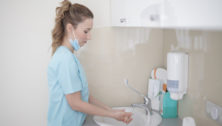Chester County Hospital Helps You Figure Out a Good Heart Rate for Your Age

When you listen to music, the different rhythms are a big part of the song. The rhythm of a drum solo might tell you you’re listening to a rock song — or the rhythm of a guitar might make you want to tango.
Rhythms make up the music we hear every day, but there’s a rhythm that’s always beating inside you, too: your heartbeat.
One easy way to know how your heart is doing is to check on its beating rhythm. Taking your pulse can help you see how well your heart is working and give you an idea about your fitness level. It can also be a warning sign for some health issues or a reminder to make healthy life choices.
It’s important to note that your resting heart rate changes as you age. So, it’s good to keep in mind what heart rate is normal and healthy for your age. Here are four things you need to know about the ideal heart rate for your age.
1. Heart Rate Vocab Words to Know
Heart rate, or pulse, refers to how many times your heart beats over a period of time. Typically, your heart rate is counted over one minute and your heart rate is measured in beats-per-minute or “bpm”.
Your resting heart rate is your heart rate when you are relaxed and not doing any physical activity. For example, your heart rate taken when you are lying or sitting down is your resting heart rate.
In general, a lower resting heart rate signals that your heart is in good health. It shows that your heart can easily keep up a regular beat while pumping more blood each time it beats. On the other hand, a higher resting heart rate can indicate that your heart has to work harder to pump blood.
You cannot measure your blood pressure by using resting heart rate — just because your heart rate is going up, doesn’t mean your blood pressure is going up the same amount. When your doctor uses a stethoscope to listen when taking your blood pressure, they’re not actually listening to the sound of your heart beating. They’re listening for the sound of your blood pumping.
2. The Expected Heart Rate for Your Age
When it comes to your heart rate, it’s sort of like the speed of your car. What you want is not too fast, not too slow, and not changing too often. But the right car speed also depends on factors such as your car’s condition and what kind of road you’re driving on.
Similarly, the ideal heart rate is different for everyone. Many factors might affect your heart rate, which differs from person to person. For example, your heart rate increases with age because the heart muscles pump blood less efficiently with time.
Children
Heart rates for children are much different from adults. As you get older, your pulse tends to slow, and young babies have the highest resting heart rate than any other time in their life.
For children, you can expect their awake heart rates to be around:
- Newborn babies: 100 to 205 beats per minute
- Infants under 1 year: 100 to 180 beats per minute
- 1 to 2 years old: 98 to 140 beats per minute
- 3 to 5 years old: 80 to 120 beats per minute
- 6 to 7 years old: 75 to 118 beats per minute
- Older children and teens: 60 to 100 beats per minute
Adults
Adults’ normal heart rate ranges are a bit slower, and the normal heart rates range from 60 to 100 beats per minute.
Apart from age and gender, other factors that can affect heart rate include how active you are, your stress levels, or what medications you’re on. Everyone’s resting heart rate is going to be a little different, so it’s good to know what might be affecting yours.
3. Checking Your Pulse at Home
You can feel your heart’s pulse on your wrist, the inside of your elbow, or the side of your neck. Many people prefer to check their pulse at their wrist, as it is the most convenient method.
Figuring out your own heart rate is easy:
- Put your middle and index fingers on your neck or wrist.
- Using a timer or a clock, count how many times your heart beats over a minute.
- You can also count your heartbeats over just 30 seconds and then multiply that number by two.
- You did it! The number of times your heart beats in a minute is your resting heart rate (which should be between 60 and 100 beats per minute).
You can also keep track of your heart rate throughout the day if you have a wearable health device. This can give you real-time information, as well as show you patterns over a longer period of time.
4. Steps to Lower Your Resting Heart Rate
Having a low resting heart rate, in general, is a sign of good heart health — higher heart rates can lead to fainting, unconsciousness and even cardiac arrest.
Surprisingly, you have more control over your heart than you think, and there are ways that you can lower your heart rate:
Exercise
Like every other body muscle, your heart gets stronger as you exercise. Physical activity makes your heart more efficient so that it uses less energy while you’re at rest. Some exercises that are especially good for your heart are yoga and aerobic exercise (like walking and jogging).
Quit Smoking
Smoking has a big impact on all aspects of your health — and that includes your heart. When you quit smoking, your heart begins to recover almost immediately. Just 20 minutes after quitting smoking, your heart rate and your blood pressure will begin to regulate to a more normal level.
Relax
In addition to taking steps to lower your heart rate over time, you may find your heart beating faster than normal due to stress or anxiety. If you have a big performance or presentation, adrenaline and nerves can get the best of you — and you may want to lower your heart rate in the moment. Breathing techniques like deep breathing or meditation can help you return your heart rate to normal and beat that stage fright or anxiety.
Learn more at the Chester County Hospital.
Connect With Your Community
Subscribe to stay informed!
"*" indicates required fields

















![95000-1023_ACJ_BannerAd[1]](https://vista.today/wp-content/uploads/2023/03/95000-1023_ACJ_BannerAd1.jpg)































